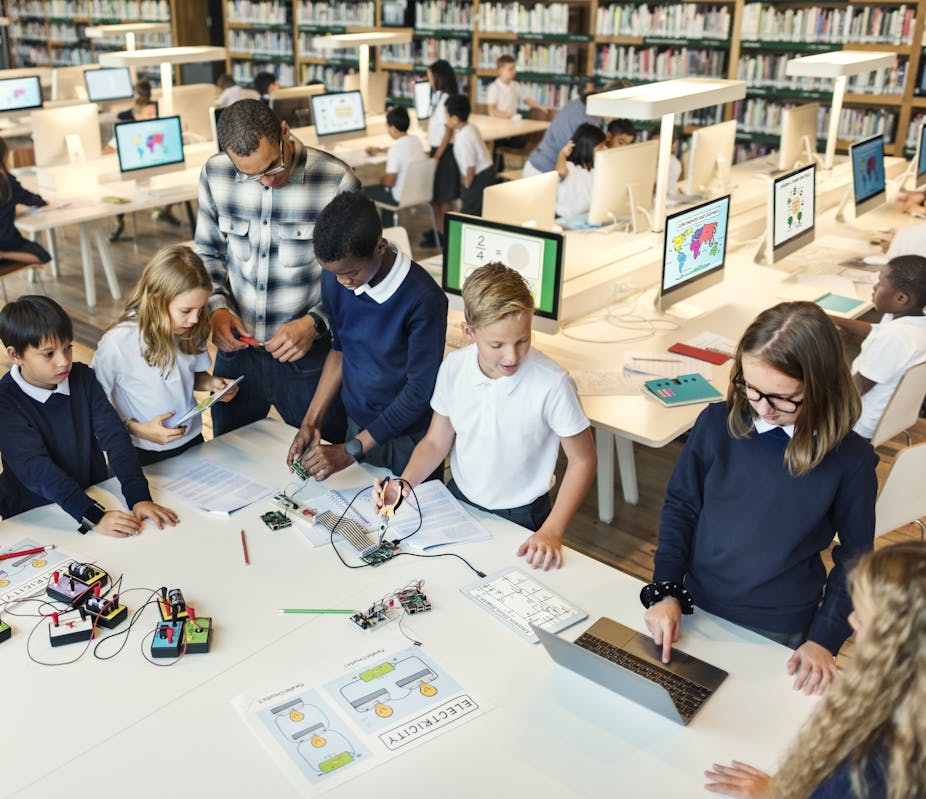An increasing policy focus in Australia, and internationally, is on getting young people interested in and studying science, technology, engineering and maths (STEM) subjects.
One approach being explored is to bring the school STEM curriculum closer to current research and practices – for instance, by engaging students in authentic inquiry and reasoning.
There are increasing numbers, and a growing diversity, of partnership arrangements where scientists, mathematicians and technology professionals interact directly with teachers and students in schools.
In addition to traditional one-off outreach visits to research laboratories or specialist centres, or incursions where scientists or engineers present on their work, there are programs where students spend time in research and industrial laboratories, or STEM professionals interact over time with teachers and students in classrooms to extend the curriculum into new areas.
Interest in charting and understanding this phenomenon has been growing in government circles.
Our own and other research over the past decade has identified significant outcomes from a range of partnerships that involve scientists working with schools on inquiry projects.
These are often built around local resources. In rural settings, for example, investigations can be related to agricultural science or ecology. This can lead to enhanced student engagement and teacher professional learning.
There are challenges, however, as teachers and scientists negotiate the boundary between their very different communities of practice.
Evaluating the model and outcomes of the CSIRO-led Scientists and Mathematicians in Schools (SMiS) program has allowed us to probe more deeply into these issues in the context of a partnership model that is potentially capable of significant, sustainable impact on the school curriculum.
Benefits for students and teachers
SMiS is an Australia-wide initiative. It matches volunteer STEM professionals with interested teachers and encourages them to develop a program that meets the school’s needs.
The research shows a range of very significant benefits for students. These include increasing engagement with STEM learning and reasoning, increased interest, enjoyment, knowledge and confidence in STEM subjects, and a greater awareness of how scientists and mathematicians think and work and of potential careers.
“The scientist is changing the culture and perception of who and what scientists do and this is really important from a gender perspective too.” (Science teacher)
For teachers, common outcomes were improved motivation and engagement in science and mathematics teaching. For primary teachers especially, confidence increased.
For STEM professionals there were also benefits. These took the form of enjoyment and passion in communicating their STEM knowledge to a new generation of students, increased understanding of, and confidence in, promoting public understandings of STEM, and gaining of alternative perspectives on their own work.
One of the scientists said:
“After discovering how the lay public misunderstands what the scientist does and that I can help to clarify this, my confidence has increased about the importance of what I do.”
It was clear that these STEM professionals were bringing to schools distinctive knowledge, skills and orientations.
Conceptual knowledge was of course important, but more so was their passion and curiosity, and their capacity to tell stories about what it is like to work and think scientifically and what can be achieved using mathematics.
Many STEM professionals helped students with investigations and ran problem-solving activities. One mathematician said:
“It is good for primary teachers to see how students can have fun with maths outside the standard curriculum. One teacher commented to me that she now understood it was more about the thinking process and not the particular numbers.”
Key to the SMiS model is that teachers and STEM professionals learn from each other, recognising and using their distinct expertise to develop productive curriculum experiences. There are notable cases of such partnerships lasting over four to seven years.
Effective model for schools?
Commitment to the partnership, clear and active communication, flexibility and effective management of expectations are important for partnerships to prosper.
We have become convinced that engaging students with STEM professionals, under the right conditions, can be a highly effective feature of school STEM curriculum.
We need, however, to develop a clearer understanding of the specific knowledge, skills and orientations that the STEM professionals bring to a school setting. This involves finding ways in which they can interact with students and teachers to make effective use of their expertise and time.
We need also to frame the curriculum to encourage and support teachers to create space to make the most of such partnership opportunities.

